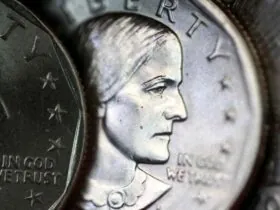Quarters are among the most iconic coins in American currency, featuring George Washington on the obverse since 1932. While they are indispensable in daily transactions, certain quarter errors can transform these coins into highly sought-after treasures worth thousands or even hundreds of thousands of dollars. In this guide, we’ll explore the fascinating world of quarter errors, detailing notable examples and the reasons behind their value.
Understanding Coin Errors
This Article Includes [hide]
Coin errors are minting mistakes that occur during the production of coins. These errors can result from the use of incorrect dies, improper planchet preparation, or misalignments during the striking process. Recognized errors are cataloged by experts and appraised based on rarity, type, and condition. Here are some of the most valuable quarter errors that have captured the attention of collectors and enthusiasts alike.
1. 2004-D Wisconsin Quarter: Extra Leaf Low

Key Details:
- Year: 2004
- Series: State Quarters
- Mint Mark: Denver
- Error: Extra Leaf Low
- Grade: MS 67
- Sale Date: January 12, 2020
- Price: $6,000
The 2004-D Wisconsin Quarter is famous for its unique “Extra Leaf Low” error. This mistake resulted in an additional leaf appearing on the corn stalk design on the reverse. The error likely occurred due to a die gouge during production, making these coins a rare and valuable find.
2. 1822 Capped Bust Quarter: 25/50c Error
Key Details:
- Year: 1822
- Series: Capped Bust
- Mint Mark: None (Philadelphia)
- Error: Denomination Struck Twice – 25c over 50c
- Grade: MS 66
- Sale Date: April 1, 2009
- Price: $184,000
This early 19th-century quarter stands out due to its double-struck denomination error. The coin’s reverse was mistakenly struck with both “25c” and “50c,” a rare oversight in minting history. Collectors prize this coin for its historical significance and the exceptional condition of surviving examples.
3. 2004-D Wisconsin Quarter: Extra Leaf High

Key Details:
- Year: 2004
- Series: State Quarters
- Mint Mark: Denver
- Error: Extra Leaf High
- Grade: MS 66
- Sale Date: July 7, 2006
- Price: $2,530
Similar to the “Extra Leaf Low” variant, this coin features an additional leaf appearing higher on the corn stalk. The “Extra Leaf High” error shares a similar origin and remains a favorite among collectors of modern quarter varieties.
4. 2000-P Maryland Quarter: Mule Error

Key Details:
- Year: 2000
- Series: State Quarters
- Mint Mark: Philadelphia
- Error: Mule – Maryland Quarter Obverse with Sacagawea Dollar Reverse
- Grade: MS 67
- Sale Date: March 21, 2018
- Price: $192,000
A “mule” error occurs when two mismatched dies are used on the same coin. In this case, a Maryland State Quarter obverse was paired with a Sacagawea Dollar reverse. This astonishing mistake resulted in one of the rarest and most valuable errors in modern numismatics.
How Coin Errors Occur
To understand how these errors come to be, it helps to know the coin production process:
- Design Creation: A large model called a galvano is crafted and reduced to coin size.
- Hub and Die Production: A master hub is used to create working dies that imprint designs onto coins.
- Planchet Preparation: Sheets of metal are cut into blank discs, or planchets, which serve as the base for the coins.
- Striking Process: Planchets are fed into presses where obverse and reverse dies stamp the designs onto the metal discs.
Errors can occur at any stage, whether it’s a die defect, planchet imperfection, or mechanical misalignment. These anomalies often make the resulting coins extremely rare and valuable.
Tips for Identifying and Collecting Error Quarters
- Learn the Basics: Familiarize yourself with common error types, such as double strikes, off-center strikes, and die gouges.
- Invest in Grading: Professional grading services can authenticate errors and assign a grade that impacts value.
- Use Reliable References: Trusted coin catalogs and guides can help identify errors and their rarity.
- Inspect Carefully: Use magnifying tools to examine your coins for unusual features.
Conclusion
Quarter errors represent a fascinating intersection of history, craftsmanship, and chance. Whether it’s a subtle die gouge or a dramatic mule error, these coins can hold immense value for collectors. By understanding the types of errors and their origins, you can better appreciate these numismatic treasures and perhaps even find one yourself!
Also Read:
THIS IS ONLY A BLOG POST FOR INFORMATION – WE DO NOT BUY, SELL, OR APPRAISE THESE ITEMS












Leave a Reply